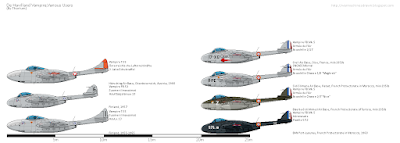The de Havilland Vampire is a British jet fighter designed and developed by the de Havilland Aircraft Company. It was the second British jet fighter to see service with the Royal Air Force (RAF), but it was also employed by many users all around the globe. Among them, the following ones:
- Austria: Austria was allowed to have an air force in 1955. The Österreichische Luftstreitkräfte (Austrian Air Force - ÖL) accepted an offer from Sweden in 1956 for 23 surplus Vampire single-seat fighters. Those were overhauled by Svensk Flygtjanst AB (a Swedish regional airline) and were acquired via a Belgian broker that same year. Eventually only three were delivered with registrations allocated for experimental or evaluation machines. By 1960 the ÖL had already disposed of them.
In 1957 the ÖL ordered one Vampire T.11 and two T.55 directly from de Havilland. They were delivered in March. Later, five more trainers were ordered, including the last T.55 built at Chester. Three ex-RAF were refurbished at Hatfield and delivered to Austria in 1964. By April 1972 all the Vampires in the ÖL were withdrawn from active service. - Finland: In 1953 the Finnish Air Force (FAF) received six Vampires FB.52. They were operated by HavLv 11 and 13 (Havittajalaivue or fighter squadron in Suomi) based at Pori (Satakunta) first and Utti (Kouvola - Kymi province) later. As in 1953 there was a shortage of aviation kerosene in Finland, paraffin oil was used instead. This oil congealed at -35ºC causing some few flame outs, without accidents.
The Vampires were grounded many times due to teething problems and lack of spares. They, however, became quite reliable with time. Between 4th July 1957 and 11th August 1958 the FB.52s were assigned to HavLv 21 of the Hame Wing, based at Luonetjarvi Air Force Base, located in the district of Tikkakoski, Jyväskylä.
As the Finnish were satisfied with the Vampires, they ordered four Vampire trainers in March 1955. They consisted on a company demonstrator and three coming from the cancelled Ceylon order. This order was later increased to 9 aircraft.
One Vampire FB.52 was supplied to the FAF 1961 by Interarmco, a weapons dealer. It was used as a ground instructional frame until 1963.
The last flight of a Finnish FB.52 took place on 2nd February 1965 while the last T.55 flew with the FAF for the last time on 15th July 1965. - France: In 1948 the Armée de l'Air (French Air Force) sought to replace its fighter squadrons with jet fighters, so they ordered 30 Vampires F.Mk.1 straight from Hatfield. To this end, five French pilots were sent to Hatfield in October 1948 for a conversion course, at the end of which, they ferried the Vampires to France.
Those 30 Vampires F.Mk.1 were delivered between 15th December 1948 and 8th January 1950 and, before that order was completed, an agreement was reached for 94 ex-RAF Vampires FB.Mk.5, all of them delivered between 31st May 1949 and 9th March 1950.
Meanwhile, the Société Nationale de Constructions Aéronautiques du Sud-Est (SNCASE - South-Western National Society of Aeronautical Constructions) signed an agreement with de Havilland to manufacture 67 Vampire FB.51 under license with parts supplied by de Havilland. It was also agreed that SNCASE would build 120 FB.51 machines with parts made in France, including the Rolls-Royce Nene engine, built under license by Hispano-Suiza.
Design differences between the FB.Mk.5 and Se.535 was considerable and had direct impact on production parts. The only similarities between both aircraft were the forward part of the fuselage, the tailplane, booms and avionics. One significant albeit small change, was the air intake in the wing roots. This part was modified by adding a thin protective section to allow the enlargement of the intake for the Nene and the fitment of a flexible fuel tank. The whole fuel system had to be redesigned so that there were 15 tanks around the aircraft against 9 in the FB.Mk.5.
This increased the fuel capacity of the Mistral, but created other problems. Pressure air-venting was required to prevent flexible tanks parting from the wing. Therefore, engine mountings were completely redesigned and the cowlings reinforced causing deformation and variation to the profile, leading to unwanted in-flight vibration. The cowling needed to be larger and stronger, so it was completely redesigned. Landing wheels were also modified by de Havilland to allow for better braking and higher tyre pressures to compensate for the increase in weight.
The first French-assembled FB.51 flew on 27th January 1950 and the first French-built FB.51 on 21st December. SNACSE divided production of the aircraft between Marignane, Marseille, where fuselage, tail booms and canopy were produced, La Corneuve, at the Seine department, where fuselage fuel tanks were produced and Toulouse, Haute-Garonne department, where sub-assemblies were built.
Flying with the Hispano-Suiza Nene 104B engine it was known as the Se.532/535 Mistral. This variant saw a total of 247 machines completed plus four pre-production machines between June 1953 and February 1954.
French Vampires were widely used against North African natives during the Algerian war of 1951-1961 as counter-insurgency aircraft fitted with rockets, bombs and napalm.
Some Vampires, among them four F.Mk.1, were modified as radio-controlled drones to test the air-to-air MATRA missile. One FB.Mk.5 was modified to test a reverse thrust Goblin engine in 1951 and two Mistrals were experimentally fitted with oleo-pneumatic skis attached to the mainwheels for trials between 1954 and 1956.
Sources:
1st Hall Park Books - Warpaint 27 - De Havilland Vampire
2nd: https://en.wikipedia.org/wiki/De_Havilland_Vampire
3rd https://en.wikipedia.org/wiki/List_of_de_Havilland_Vampire_operators


No comments:
Post a Comment